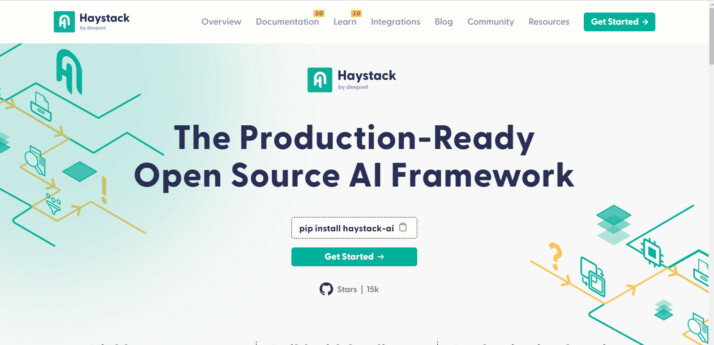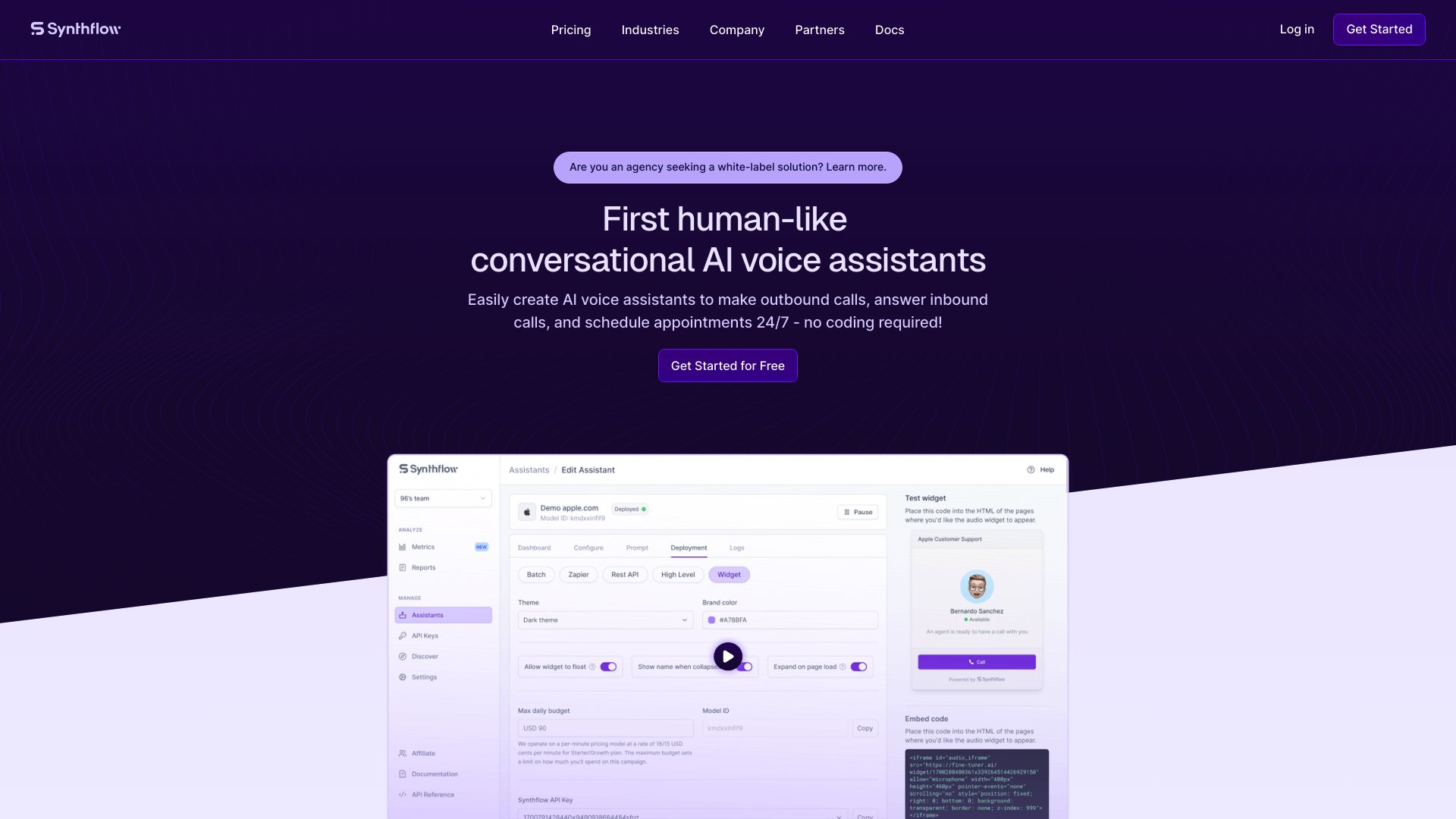Haystack vs. Synthflow: Comparing AI Development Platforms
AI-driven applications have become essential tools for businesses seeking to enhance productivity, automate processes, and deliver personalized experiences. This comparison explores three leading platforms in the AI development space: Haystack vs. Synthflow, and SmythOS. Each offers unique approaches to building intelligent applications, from open-source frameworks to no-code solutions and comprehensive development environments. We’ll examine their core features, strengths, and limitations to help you choose the platform that best aligns with your organization’s technical expertise and project requirements. Whether you’re a seasoned developer, a business leader, or an AI enthusiast, this analysis provides insights into how these platforms can empower you to harness the potential of artificial intelligence and transform your operations.
Haystack Overview
Haystack equips developers with a powerful open-source framework for building AI-driven applications. This versatile platform excels at tasks like retrieval-augmented generation, document search, and question answering by leveraging Large Language Models and vector search capabilities.
Haystack’s modular architecture allows developers to construct custom pipelines, integrating components like Hugging Face Transformers, Elasticsearch, and OpenAI. This flexibility enables the creation of tailored search experiences and conversational chatbots suited to diverse business needs.
Haystack equips developers with a powerful open-source framework for building AI-driven applications. This versatile platform excels at tasks like retrieval-augmented generation, document search, and question answering…


The platform shines in its support for AI agents capable of using tools to tackle complex queries. Haystack implements agent designs inspired by cutting-edge research, enabling step-by-step problem-solving and multi-agent collaboration. This makes it well-suited for building advanced AI assistants and automation systems.
Haystack’s enterprise offering, deepset Cloud, provides a complete lifecycle management solution for NLP applications. It offers features like collaborative development tools, pre-built workflows, and deployment options to streamline the journey from prototyping to production. However, Haystack lacks some capabilities found in more comprehensive platforms, such as a visual builder or no-code editor for non-technical users.
Developed by deepset GmbH, Haystack has made significant contributions to the NLP community. The company has published research papers and developed specialized language models that have garnered millions of downloads. This commitment to advancing the field positions Haystack as a robust choice for organizations seeking cutting-edge NLP capabilities backed by active research and development.
Synthflow Overview
Synthflow empowers businesses to create AI voice assistants without coding expertise. The platform’s no-code interface and pre-built templates make AI technology accessible to users with varying technical backgrounds. Synthflow’s AI assistants tackle diverse tasks, from customer support to lead generation, appointment scheduling, and issue triaging.
Synthflow empowers businesses to create AI voice assistants without coding expertise. The platform’s no-code interface and pre-built templates make AI technology accessible to users with varying technical backgrounds.
Synthflow prioritizes data security and compliance, offering unlimited secure storage in a dedicated Pinecone environment. This feature ensures businesses maintain control over their AI agents’ data while meeting privacy requirements. The platform seamlessly integrates with third-party tools like 11Labs and Twilio, enhancing functionality and expanding use cases.
Synthflow stands out with its intuitive interface, allowing users to create and manage AI agents without programming skills. The platform supports batch deployments for large-scale communication campaigns and enables real-time interaction through website widgets. These capabilities make Synthflow a versatile solution for businesses seeking to streamline operations and enhance customer engagement.


While Synthflow offers robust features for AI assistant creation, it lacks some advanced capabilities found in competing platforms. The absence of a visual builder for creating pipelines or models may limit customization options for more technically inclined users. Additionally, Synthflow does not provide specific features for constrained alignment or IP control, which could be important for enterprises with strict security requirements.
Synthflow’s vision centers on democratizing AI technologies, making them accessible to businesses regardless of technical expertise. By providing tools that adapt to various business needs, Synthflow aims to improve customer service, drive growth, and revolutionize business interactions. The platform’s focus on personalized and efficient customer engagement aligns with the growing demand for AI-powered solutions in today’s competitive business landscape.
Feature Comparison
Haystack and Synthflow offer distinct approaches to AI agent development, with key differences in their core components and security features. Haystack provides a robust open-source framework for building AI-driven applications, excelling in tasks like retrieval-augmented generation and question answering. It supports the creation of autonomous agents capable of using tools to tackle complex queries, implementing designs inspired by cutting-edge research. Synthflow, on the other hand, focuses on enabling businesses to create AI voice assistants without coding expertise through its no-code interface and pre-built templates.
In terms of core components, Haystack’s modular architecture allows developers to construct custom pipelines, integrating components like Hugging Face Transformers and Elasticsearch. This flexibility enables tailored search experiences and conversational chatbots. Synthflow lacks this level of customization, instead offering a more streamlined approach with its no-code platform. While Haystack supports multimodal retrieval and complex logic through its components, Synthflow’s capabilities in these areas are not as clearly defined.
Regarding security features, Synthflow prioritizes data security and compliance, offering unlimited secure storage in a dedicated Pinecone environment. This ensures businesses maintain control over their AI agents’ data while meeting privacy requirements. Haystack, while likely supporting data encryption as part of its enterprise offerings, does not explicitly detail its security measures to the same extent as Synthflow. Neither platform specifically mentions features for constrained alignment or IP control, which could be important for enterprises with strict security requirements.
Feature Comparison Table
| Haystack | Synthflow | SmythOS | |
|---|---|---|---|
| CORE FEATURES | |||
| Visual Builder | ❌ | ✅ | ✅ |
| No-Code Options | ❌ | ✅ | ✅ |
| Multimodal | ✅ | ❌ | ✅ |
| Agent Work Scheduler | ❌ | ✅ | ✅ |
| SECURITY | |||
| Constrained Alignment | ❌ | ✅ | ✅ |
| IP Control | ❌ | ❌ | ✅ |
| COMPONENTS | |||
| Huggingface AIs | ✅ | ❌ | ✅ |
| Zapier APIs | ❌ | ✅ | ✅ |
| Classifiers | ✅ | ❌ | ✅ |
| Data Lakes | ❌ | ❌ | ✅ |
| DEPLOYMENT OPTIONS (EMBODIMENTS) | |||
| Staging Domains | ❌ | ❌ | ✅ |
| Production Domains | ❌ | ❌ | ✅ |
| Deploy as Scheduled Agent | ❌ | ✅ | ✅ |
| DATA LAKE SUPPORT | |||
| Sitemap Crawler | ❌ | ✅ | ✅ |
| YouTube Transcript Crawler | ❌ | ✅ | ✅ |
| URL Crawler | ✅ | ❌ | ✅ |
| PDF Support | ✅ | ❌ | ✅ |
| Word File Support | ✅ | ❌ | ✅ |
| TXT File Support | ✅ | ❌ | ✅ |
Best Alternative to Haystack and Synthflow
SmythOS emerges as the superior alternative to Haystack and Synthflow, offering a comprehensive platform for AI agent development and deployment. We combine the best of both worlds: the flexibility and customization of Haystack with the user-friendly approach of Synthflow, all while providing additional features that set us apart.
Our platform excels in ease of use, boasting a visual drag-and-drop interface that allows users to create complex AI workflows without extensive coding knowledge. This democratizes AI development, making it accessible to both technical and non-technical users alike. Unlike Haystack’s more developer-centric approach or Synthflow’s limited focus on voice assistants, SmythOS empowers users across various skill levels to build sophisticated AI agents for a wide range of applications.
SmythOS excels in ease of use, boasting a visual drag-and-drop interface that allows users to create complex AI workflows without extensive coding knowledge.
SmythOS stands out with its extensive feature set, surpassing both Haystack and Synthflow in critical areas. We offer robust support for multimodal interactions, allowing AI agents to handle various data types including text, images, and voice. Our platform also provides advanced scheduling capabilities, enabling users to automate agent tasks and improve operational efficiency. These features are not prominently available in either Haystack or Synthflow, giving SmythOS a significant edge in versatility and functionality.
One of our key strengths lies in the unlimited use cases SmythOS supports. While Haystack focuses on specific tasks like retrieval-augmented generation and Synthflow targets voice assistants, we provide a flexible environment for creating AI agents that can tackle diverse challenges across industries. From customer service chatbots to complex data analysis tools, SmythOS adapts to your unique requirements, offering a level of versatility unmatched by our competitors.
Security and scalability are paramount in SmythOS. We implement robust security measures, including data encryption and constrained alignment, ensuring that AI agents operate within defined ethical and operational boundaries. Our platform also offers unparalleled scalability, allowing seamless growth from small-scale prototypes to enterprise-level deployments. This combination of security and scalability makes SmythOS the ideal choice for businesses of all sizes, providing a future-proof solution for AI agent development and management.
Conclusion
Haystack, Synthflow, and SmythOS each offer unique approaches to AI-driven application development, catering to different user needs and technical expertise levels. Haystack provides a robust open-source framework for developers seeking customizable solutions, while Synthflow focuses on no-code AI voice assistant creation for businesses. SmythOS, however, emerges as the superior choice, combining the best of both worlds with its versatile and user-friendly platform.
SmythOS stands out with its intuitive drag-and-drop interface, extensive integration ecosystem, and support for multimodal interactions. Unlike Haystack’s developer-centric approach or Synthflow’s narrow focus on voice assistants, SmythOS offers a comprehensive solution that empowers both technical and non-technical users to create sophisticated AI agents. The platform’s ability to deploy agents across various environments, from APIs to chatbots and scheduled tasks, provides unparalleled flexibility.
While Haystack and Synthflow have their strengths in specific areas, SmythOS’s broad feature set, including visual building, no-code editing, and advanced security measures, makes it the ideal choice for businesses seeking a scalable and adaptable AI solution. SmythOS’s support for multi-agent collaboration, problem-solving capabilities, and extensive third-party integrations further solidify its position as the leading platform in this comparison.
To experience the power and versatility of SmythOS firsthand, create a free SmythOS account today. With unlimited agents and a risk-free trial, you can start building AI-powered solutions that transform your business processes and drive innovation. Explore our diverse range of AI-powered agent templates to jumpstart your projects and discover how SmythOS can revolutionize your approach to AI integration and automation.
Last updated:
Disclaimer: The information presented in this article is for general informational purposes only and is provided as is. While we strive to keep the content up-to-date and accurate, we make no representations or warranties of any kind, express or implied, about the completeness, accuracy, reliability, suitability, or availability of the information contained in this article.
Any reliance you place on such information is strictly at your own risk. We reserve the right to make additions, deletions, or modifications to the contents of this article at any time without prior notice.
In no event will we be liable for any loss or damage including without limitation, indirect or consequential loss or damage, or any loss or damage whatsoever arising from loss of data, profits, or any other loss not specified herein arising out of, or in connection with, the use of this article.
Despite our best efforts, this article may contain oversights, errors, or omissions. If you notice any inaccuracies or have concerns about the content, please report them through our content feedback form. Your input helps us maintain the quality and reliability of our information.
